Music of the Chicano Movement
Lesson Hub 6:
"¡Sí se puede!"
Advocating for Farm Workers
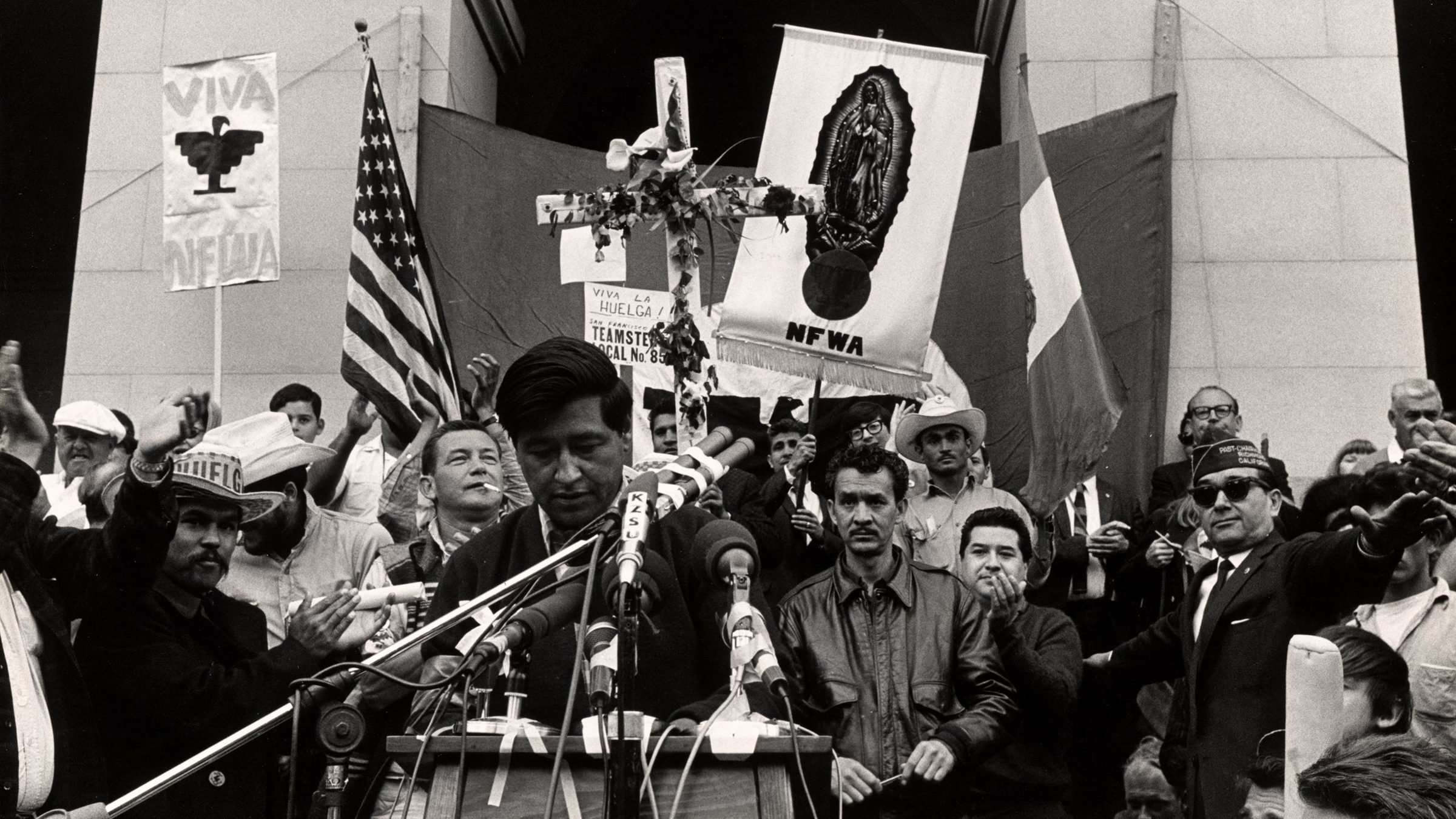

How did music and musicians inspire, motivate, and unite farm workers, activists, and supporters as they fought for fair wages and safe working conditions?

Boycott Grapes, Support the United Farm Workers Union, Xavier Viramontes. Smithsonian American Art Museum.
The overarching essential question for Lesson 6 is:

"¡Sí se puede!": Advocating for Farm Workers
HISTORY & CULTURE
MUSIC LISTENING
MUSIC MAKING

Boycott Grapes, Support the United Farm Workers Union, by Xavier Viramontes. Smithsonian American Art Museum.
40+ MIN
30 MIN
25+ MIN
"¡Sí se puede!" (Yes We Can)!
Path 1


40+ minutes

Sí Se Puede Boycott Lettuce and Grapes, unknown artist. National Museum of American History.
Listen to an excerpt from this audio recording.
What do you think this song is about?
"¡Sí se puede!" (Yes We Can)!


The Farm Workers Movement



The lyrics of this song, “Niños campesinos” (farmworker children) address a distinct facet of the Chicano movement (1960s–1970s) that focused on farm workers’ rights.
Listen to this song again while examining an excerpt from the lyrics more closely (which illustrate the plight of many migrant farm workers during this time).
Listening for Meaning: "Niños campesinos"



Group of Children Posing under Sign That Reads "U.S. Department of Agriculture Farm Security Administration Farm Workers Community," photo by Robert Hemmig. American Folklife Center, Library of Congress.
"¡Sí se puede!" (Yes We Can)!

Listen to another short excerpt from the same recording.
This time, think about a new guiding question:
How do you think this song was used during the Chicano movement?


Performance Context
At farm worker rallies and union meetings, upbeat/fun (yet relevant/relatable) songs like "Niños campesinos" were often used to entertain and lift the spirits of workers who were striking, as well as supporters of these efforts.

Agustín Lira and El Teatro Campesino, photo by Jon Lewis. Smithsonian Folkways Recordings.
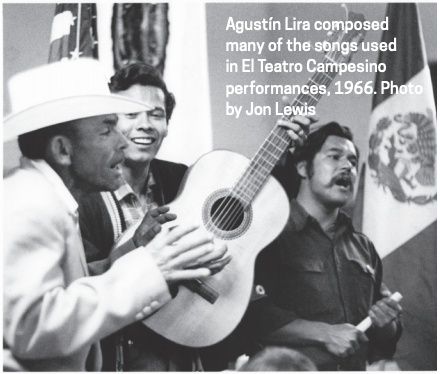

Adding Historical Context: NFWA

In 1962, César Chávez and Dolores Huerta co-founded an organization called the National Farm Workers Association (NFWA) – the first successful farm workers union in the country.

Pinback Button for the National Farm Workers Association, unknown artist. National Museum of American History.
Adding Historical Context


Chávez and Huerta often organized strikes and boycotts to negotiate for higher wages and better working conditions for workers in the fields.
Chávez and Huerta’s efforts became widely known as “La Huelga!” (The Strike!).

Dolores Huerta, Delano, California, photo by Harvey Richards. Courtesy of the Harvey Richards Media Archive.

Huelga Songs

The song you heard earlier, “Niños campesinos,” was known as a "huelga song".
Huelga songs were meant for communal singing.
Singing together created feelings of unity and gave people courage to continue the strike (la huelga) . . . even when they faced danger in doing so.

Teatro Campo "La Huelga," printed by the Allied Printing Trades Council. National Museum of American History.
Spotlight: César Chávez


César’s family lost their small farm in Arizona during the Great Depression (1930s).
They joined the migration to California and began working in the fields.
César dropped out of school in 8th grade to work in the fields full-time.
He was well-known for his persistence and his non-violent approach to protest/change-making.
He had an unconventional leadership style:
- He was soft-spoken and not a particularly dynamic speaker.
- He preferred communicating one-on-one with workers over speaking in front of large crowds.
Cesar Chavez, photo by Harvey Richards. Courtesy of the Harvey Richards Media Archive.
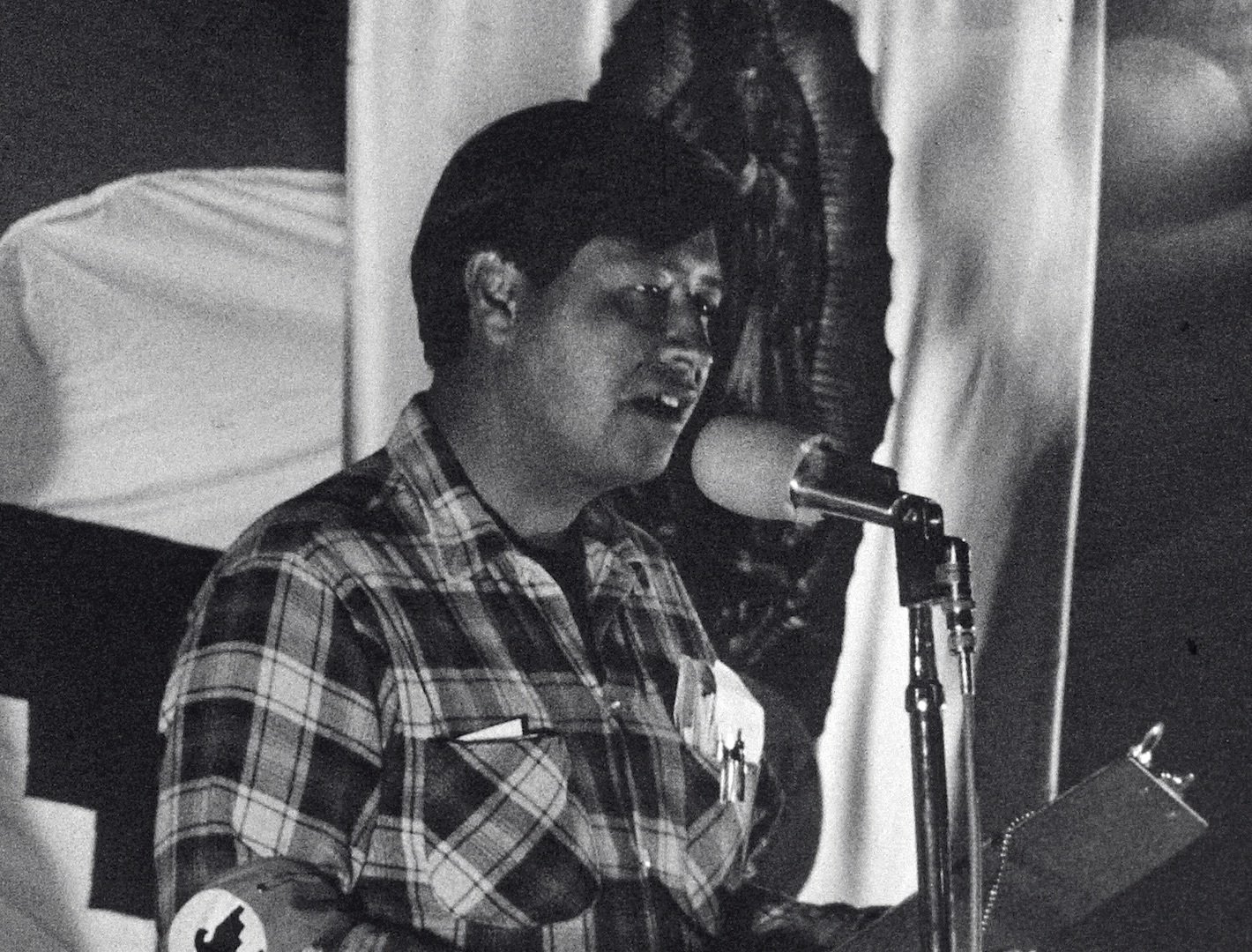
Spotlight: César Chávez


Making Music for the march: Agustín Lira on César Chávez. Smithsonian Center for Folklife and Cultural Heritage
Extension Activity: César Chávez


Click the button below to read a short article on César Chávez from Smithsonian Magazine:
United Farmworkers Poster, printed by Lithographers and Photoengravers International Union. National Museum of American History.

Spotlight: Dolores Huerta

Unlike Chávez, Dolores Huerta did not grow up working in the fields.
From a young age, Dolores loved to organize and was an active participant in several youth organizations (such as Girl Scouts).
She wanted to help others and end the poverty she saw around her.
An articulate and energetic speaker, Huerta led the union’s public relations efforts, conveying the movement’s values and aims to the larger public in print, radio, and television.
She was also instrumental in bolstering the morale of workers on the picket line: She made the phrase “¡Sí se puede!” (Yes We Can!) famous.
Dolores Huerta Speaks at UFW Rally, unknown photographer. Courtesy of the Walter P. Reuther Library, Archives of Labor and Urban Affairs, Wayne State University.


Spotlight: Dolores Huerta

¡Sí se puede! One life: Dolores Huerta. Video by the Smithsonian Center for Learning and Digital Access & National Portrait Gallery
Goals of the Farm Workers Movement


The primary goals of the farm workers movement were simple and straightforward:
Goal 1 – Secure higher wages for migrant farmworkers
- …many of whom were Mexican Americans.
- In the 1960s, most migrant farmworkers made between $.65–.$85 per hour.
- This wage kept many families "mired in cyclical poverty" (Montoya, 2016, p. 39).
Goals of the Farm Workers Movement


Goal 2 – Make working conditions in the fields safer and more humane

Short-Handled Hoe, unknown maker. National Museum of American History.
Braceros Working with Short-Handled Hoes, photo by Leonard Nadel. National Museum of American History.
Farm workers were exposed to harmful pesticides for long hours and were often required to use tools that caused long-term physical injuries, such as the short-handled hoe.

Strategies

Chávez, Huerta, and other leaders used two general strategies to achieve their goals: strikes and boycotts.



Strikes

Strikes disrupted the harvest of crops and therefore put pressure on growers to listen and respond to the farm workers' demands.

Huelga/no violencia/en Salinas, unknown artist. National Museum of American History.

Boycotts

Boycotts were more visible to the general public, and therefore raised public awareness and sympathy for the farm worker’s plight.

Boycott Grapes & Lettuce, by Ricardo Favela. Smithsonian American Art Museum.
Setbacks


The farm workers’ journey towards attaining higher wages and better working conditions was long and difficult, with many setbacks along the way.
Setbacks


Growers were rich and had a significant amount of power (and the support of politicians and the police).
Growers were often able to hire “strikebreakers” (other workers who were willing to step in and do the work, sometimes for a lower wage).
It was difficult to keep workers who needed money on the picket line for more than short periods of time and it sometimes took long periods of time before observable gains were attained.


A New Strategy: Collaboration

Over time, César Chávez and the leader of another union called the Agricultural Workers Organizing Committee (Larry Itliong) began to recognize their efforts would be more successful if they worked together.
- In 1966, Chávez and Itliong decided to combine forces as they worked toward common goals.
- These organizations merged and became the United Farm Workers (UFW)–a union that is still intact today.

Huelga, United Farm Workers Flag, by the American Federation of Labor and Congress of Industrial Organizations. National Museum of American History.

Video: Filipino Contributions to the Movement

|
Filipinos in the UFW Movement: Agustin Lira & Patricia Wells Solorzano on Larry Itliong, by Charlie Weber and Daniel Sheehy. Smithsonian Center for Folklife and Cultural Heritage. |

Extension Activity: Learn about Larry Itliong

Click below to read an article about Larry Itliong from Smithsonian Magazine.
Larry Itliong, unknown photographer. Smithsonian Magazine.
Music as Motivation


When things got tough, music remained a motivating force that inspired farm workers and activists to persevere.

Right: El Teatro Campesino, photograph by Diana Jo Davies. Ralph Rinzler Folklife Archives and Collections, Smithsonian Institution.
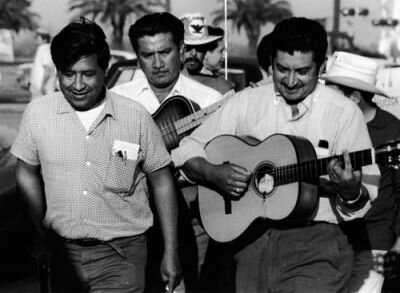
Left: César Chávez Marches with the Musicians, by Jon Lewis. Farmworker Documentation Project, presented by the UC Santa Barbara Library.
Listen to an excerpt from another huelga song called “Yo no le tengo miedo a nada” (I am not afraid of anything).
Think about this question:
What is the performance context of this recording?
"Yo no le tengo miedo a nada"


Performance Context: "Yo no le tengo miedo a nada"


This live performance was recorded at a union meeting.
Agustín Lira, the musician interviewed in the previous videos, wrote and performed this song along with other musicians during the time of the farm workers movement.
This recording (and image) conveys the importance of audience participation.

Agustin Lira and Luis Valdez Perform at a Farmworker Rally, photo by Jon Lewis. Smithsonian Folkways Recordings.
Listen again, while looking at the lyrical excerpt.
Think about this question:
What do you think the term "scab" means?
Listening for Meaning: "Yo no le tengo miedo a nada"


What is a Scab?


"Scab" was another name for a "strikebreaker."
A scab was someone, often an undocumented Mexican migrant, who came to work in the fields when union workers went on strike.
Braceros Picking Lettuce, photo by Leonard Nadel. National Museum of American History.


"Scabs" Continued

The lyrics of this song reflect the resentment many union workers felt about the people who crossed the picket lines and replaced them in the fields.
These lyrics also emphasize and celebrate the perceived courage of union workers who stood up to their oppressors (the growers).
Farmworkers Strike to Save Their Union, unknown artist. National Museum of American History.

Farm Workers Movement or Chicano Movement?


The farm workers movement was different from the other facets of the Chicano movement in several important ways:
- Attaining civil rights was not the primary focus. Tangible “bread and butter” objectives, such as higher wages and better working conditions were most important.
- Chicano identity and ethnic pride were not emphasized. The movement focused on economic justice for farm workers in general.
- Union efforts focused on U.S. citizens and long-term residents, not Mexican nationals and/or undocumented immigrants (who were viewed as competitors).
- The UFW was a multi-ethnic organization (e.g., many Filipinos also held leadership roles).
Legacies of the Farm Workers Movement


Despite these differences, the farm worker/labor movement was intertwined with and had a lasting, indisputable impact on the Chicano movement at large. For example:
- Farm worker strikes inspired young Chicano activists around the country and helped them realize that grassroots efforts really could lead to positive change.
- Musicians associated with the farm worker’s movement demonstrated the important role that music and theater “could play in developing political consciousness” (Montoya, 2016, p. 54).

Rally at Placita Park, photo by Luis C. Garza. UCLA Chicano Studies Research Center.

Enduring Symbols from the Farm Workers Movement

The farm worker flag and its emblem, the black eagle (shown on the right), eventually became a major symbol of the Chicano movement in a more general sense.


Learning Checkpoint
- What were the primary goals of the Farm Workers Movement (La Huelga)?
- What strategies did César Chávez, Dolores Huerta, and other leaders use to achieve these goals?
- How was music used within the context of the farm workers movement?

End of Path 1! Where will you go next?






"De colores": Music of the March
Path 2

30 minutes


Singing "De colores" on the UFW Picket Line, photo by Hub Segur. Smithsonian Folkways Recordings.
Attentive Listening

Listen to a short excerpt from this audio recording (30–45 seconds). As you listen, think about the following question:
Have you heard this song before? If so, where?

"De colores" is one of the most famous Spanish language folk songs in the world.
About "De colores"


This song gained popularity in the United States during the farm workers movement in the 1960s and 1970s. It has been called the “union’s theme song” (Montoya, 2016, p. 49).
Although it is difficult to pinpoint the exact origin of "De colores," it most likely originated in Spain and was brought to North America during the Spanish Conquest (sixteenth century).


Attentive Listening: Performers

Listen again. As you listen, think about the following question:
Who is singing?

Los Lobos del Este de Los Angeles

This recording was made by Los Lobos del Este de Los Angeles in 1977.
They recorded it with a group of schoolchildren from East Los Angeles.
Although this song has many verses, only the two most common verses are included on this recording.
Louie Pérez, Musician (Los Lobos), photo by Harry Gamboa Jr. National Portrait Gallery.


Listen to two more short excerpts from this recording. Think about a new guiding question each time.
1. What do you notice about the time/meter?
2. What do you notice about the melody/harmony?
Attentive Listening: Time and Pitch



"De colores": Time and Pitch
This song is in ¾ time (three beats per measure).
There are two distinct vocal parts:
- It can be hard to distinguish the melody from harmony
- Both vocal parts are important in order to capture the essence of this song

Listening for Meaning

Listen again to the first verse of the song:
This time, take a closer look at the song lyrics.
What do you think they mean?

Notable Themes in "De colores" Lyrics

- The world is a beautiful place
- Tolerance (all people of all colors are beautiful)
- Religious undertones (God’s creations are beautiful… we are loved by God)
- In the context of the farm workers movement, these lyrics can be interpreted as a reflection of the union’s non-violent strategies


Engaged Listening: Sing Along!

Sing "De colores":
- Start by humming and/or singing along with and in the style of the singers on the audio recording.
- Optional Extension: Consider adding instruments and practice singing without the recording!

During farm worker rallies and marches, people would often join hands and sway while singing "De colores."
Adding Historical and Cultural Context



Although "De colores" was sung at a wide variety of farm worker events, it is most commonly associated with a famous march from Delano to Sacramento, CA in 1966.
Adding Historical and Cultural Context

Vineyard March, by Richard Correll. National Museum of American History.

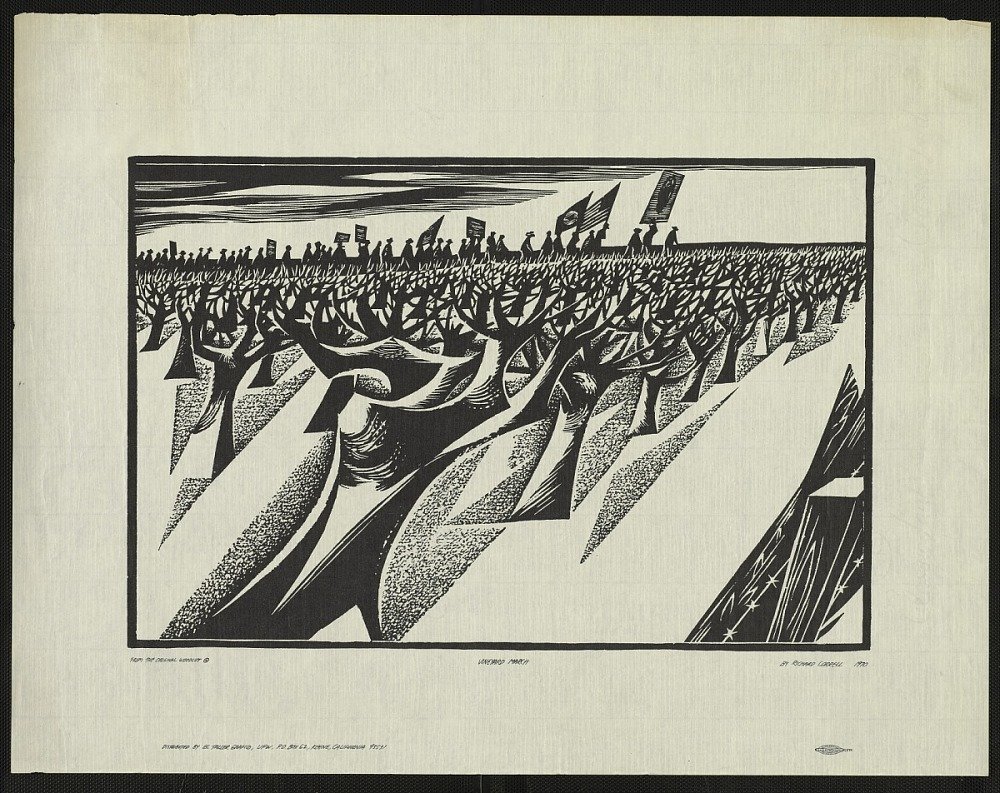
The "Pilgrimage"

César Chávez, who was inspired by the non-violent marches led by Martin Luther King Jr., thought this march (branded a "pilgrimage") would be an effective way to attract positive publicity and gain new union members.

Farm Workers March from Delano to Sacramento in 1966, photo by Harvey Richards. Courtesy of the Harvey Richards Media Archive.

The Pilgrimage Continued

This famous march was a 300-mile+ journey that lasted 25 days.
“The march grew in number with every rural town it met along the way” (Montoya, 2016, p. 49). It began with 100 and ended with 10,000 participants.

Delano to Sacramento
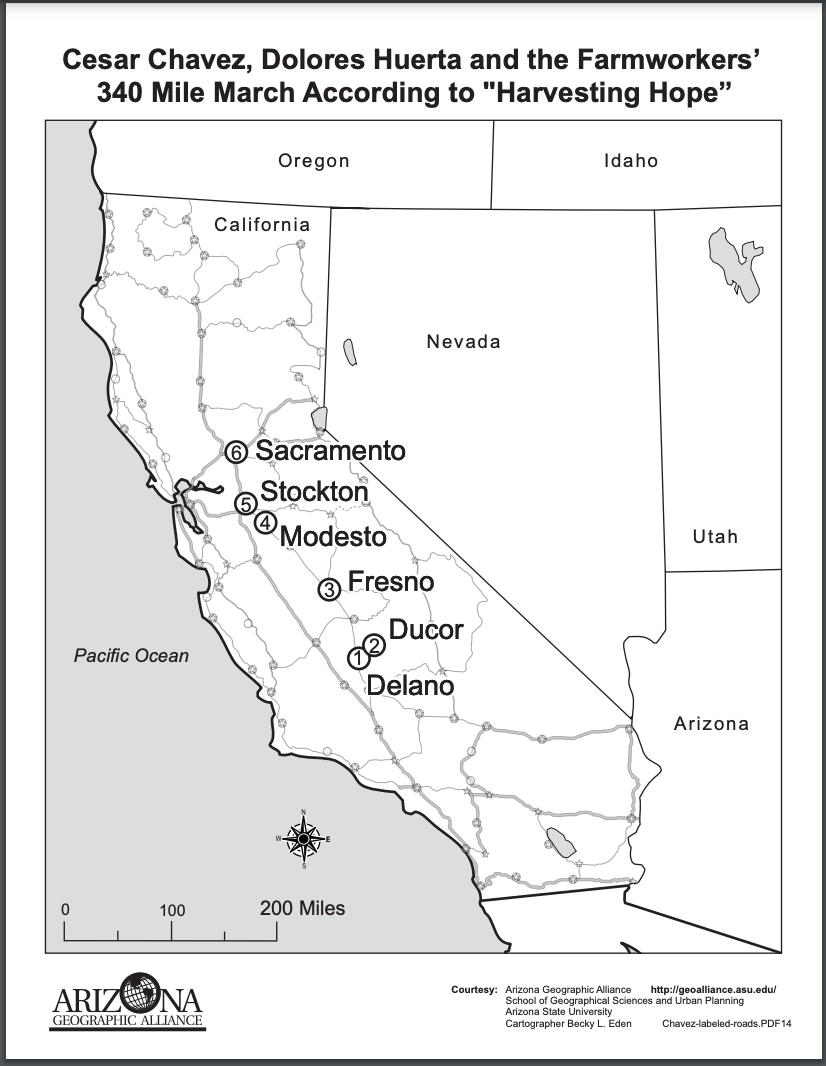
Cesar Chavez, Dolores Huerta, and the Farmworkers' 340-Mile March According to "Harvesting Hope", by Becky L. Eden. Courtesy of the Arizona Geographic Alliance, Arizona State University.
This pilgrimage had notable religious undertones. For example:
- Marchers often invoked the image of the Virgin of Guadalupe.
- Catholic mass was celebrated daily
- Marchers arrived in Sacramento on Easter Sunday.
Like the song "De colores" . . .


César Chávez, photo by Ernest Lowe. National Portrait Gallery.


Sing "De colores" One Last Time:
Is your experience singing this song different after learning about the context in which it was sung during the farm workers movement?


Learning Checkpoint
- In what contexts was "De colores" sung during the time of the Chicano movement?
- What is unique about the melody/harmony lines in the song "De colores?"

End of Path 2! Where will you go next?






Exploring the Music of El Teatro Campesino
Path 3

25+ minutes

El Teatro Campesino Poster, unknown artist. National Museum of American History.
El Teatro Campesino was a popular music and theater troupe that emerged during the farm workers movement.
El Teatro Campesino

El Teatro Campesino, viva la huelga!, unknown artist. Smithsonian American Art Museum


El Teatro Campesino

Founded by field workers who were also musicians (Luis Valdez, Agustín Lira, and Felipe Cantú), El Teatro Campesino became one of the most enduring symbols of the Chicano movement.

El Teatro Campesino, photo by Diana Jo Davies. Ralph Rinzler Folklife Archives and Collections, Smithsonian Institution.

The main mission of El Teatro Campesino was to energize the political message of the farm workers movement through song, music, and drama.
El Teatro Campesino

El Teatro Campesino Poster, unknown artist. National Museum of American History.


More about El Teatro Campesino
El Teatro Campesino performances were entertaining and addressed farm workers’ issues.
The actors and singers who comprised this traveling theater troupe used humor to help people process difficult events as they were happening.
“Friday Night” union meetings were usually packed, in large because people looked forward to watching El Teatro Campesino’s performances.

Agustín Lira and El Teatro Campesino, photo by Jon Lewis. Smithsonian Folkways Recordings.

Attentive Listening: "El Picket Sign"

Listen to five short clips from El Teatro Campesino’s popular song, "El Picket Sign."
Each time, think about a new guiding question:

1. Which instruments do you hear?
2. What do you notice about the time/meter?
3. What do you notice about the melody?
4. What do you notice about the vocal harmonies?
5. What do you notice about the song structure?
1. This song includes guitars and voice.
2. This song has a distinct duple meter feel.
3. The melody is catchy and singable.
4. At times, there is three-part vocal harmony.
5. This song has a verse/refrain structure.
Attentive Listening: "El Picket Sign"



The lyrics from “El Picket Sign” emphasize the ways in which the “picket sign” can serve as an important weapon during social movements.
Children, Pickets, Grape Boycott, 1968, unknown photographer.
Walter P. Reuther Library, Archives of Labor and Urban Affairs, Wayne State University.

About the Lyrics

Artist Spotlight: Luis Valdez

Luis Valdez, one of the co-founders of El Teatro Campesino, wrote the lyrics for the song "El Picket Sign." His voice is heard prominently on the recording. Luis believed that "theater should respond to and grow out of the social conditions where it is most necessary – in this case, the picket line" (Montoya, 2016, p. 52).
Luis Valdez, photograph by Diana Jo Davies. Ralph Rinzler Folklife Archives and Collections, Smithsonian Institution.


Agustín Lira, another co-founder of El Teatro Campesino, composed many of the songs used for the group’s performances. In 2016, he stated, “I think that they are the most important tools, theater and music, to educate the community, to bring it along over the years, because the arts go so profoundly deep” (from the Songs of Struggle and Hope liner notes).
Artist Spotlight: Agustín Lira


Agustín Lira, photo by Jon Lewis. Smithsonian Folkways Recordings.
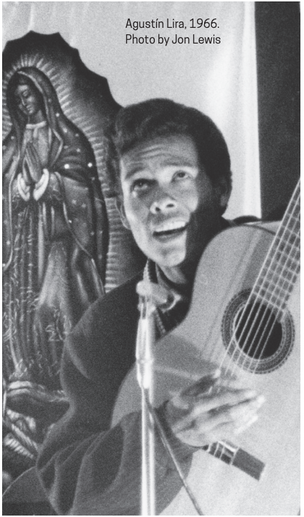
Agustín Lira and Luis Valdez’s brother Daniel Valdez (another member of El Teatro Campesino) are featured on the next song.
As you listen, think about the following guiding question:
From a musical perspective, how does this song differ from “El Picket Sign”?
Attentive Listening: "The Migrant's Song"


About "The Migrant's Song"

- It has a distinct triple meter feel.
- The song lyrics are in English.
- There are only two voices on the recording.
- The two-part vocal harmony happens only during the refrain.
- It has a more somber mood.
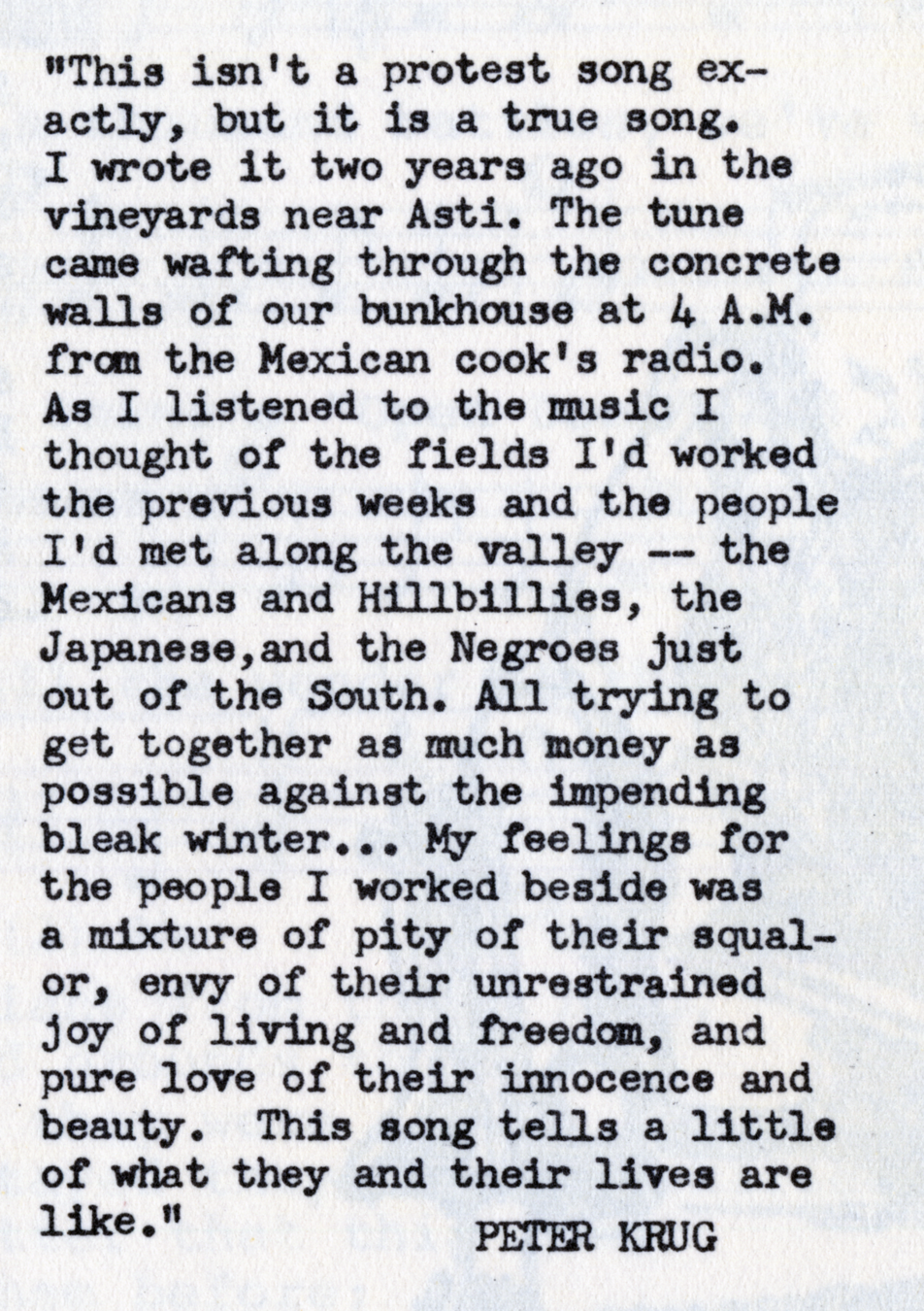
Information about "The Migrant's Song," by Peter Krug. Broadside Records.
Peter Krug, the composer of "The Migrant’s Song," had this to say about its meaning:


Engaged Listening: "The Migrant's Song"
Listen to "The Migrant’s Song" again (or several more times)!
- Pat, clap, or step the time structure (3/4 time).
- Try to sing along with the recording.
- Add the vocal harmony on the refrain.
- If you know how to play a chordal instrument, consider strumming along.


The Migrant's Song, provided by Peter Krug. Broadside Records.

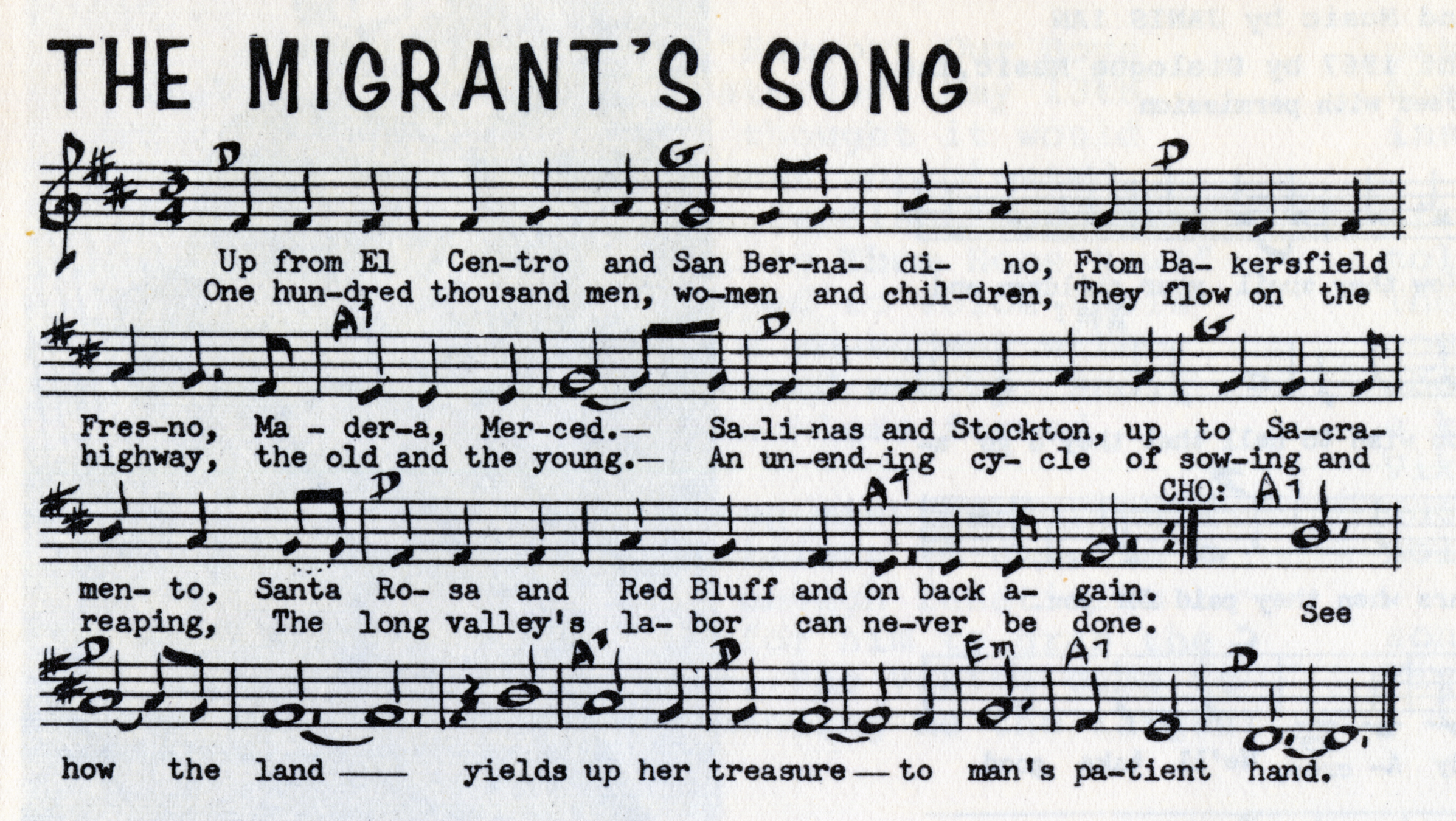
El Teatro Campesino’s reach ultimately extended far beyond the farm workers movement and had a lasting impact on the Chicano movement at large.
“Wherever Chicanos gathered under the Chicano movement rubric, teatros were established” (Rosales, 1997, p. 256)
El Teatro Campesino's Reach




. . . both Valdez and Lira went on to have successful careers in the music/entertainment industry.
Trío Alma, photo by Daniel Sheehy. Smithsonian Folkways Recordings.



After the Chicano movement . . .

Learning Checkpoint
- What was El Teatro Campesino?
- How did El Teatro Campesino energize the political messages of the farm workers movement?
- What are some musical characteristics of El Teatro Campesino's songs, "El Picket Sign", and "The Migrant's Song"?

End of Path 3 and Lesson Hub 6! Where will you go next?








Audio courtesy of:
Smithsonian Folkways Recordings
Video courtesy of:
Smithsonian Center for Folklife and Cultural Heritage
Smithsonian Education
Images courtesy of:
American Folklife Center, Library of Congress
Arizona Geographic Alliance, Arizona State University
TM/© 2021 the Cesar Chavez Foundation. www.chavezfoundation.org
Filipino American National Historical Society
Harvey Richards Media Archive
National Museum of African American History and Culture
National Museum of American History
National Portrait Gallery
Ralph Rinzler Folklife Archives and Collections
Smithsonian American Art Museum
Smithsonian Folkways Recordings
Walter P. Reuther Library, Archives of Labor and Urban Affairs, Wayne State University
Beinecke Rare Book & Manuscript Library, Yale University
Lesson Hub 6 Media Credits

© 2021 Smithsonian Institution. Personal, educational, and non-commercial uses allowed; commercial rights reserved. See Smithsonian terms of use for more information
This Lesson was funded in part by the Smithsonian Youth Access Planning Grant.
For full bibliography and media credits, see Lesson 6 landing page.






